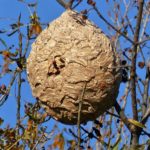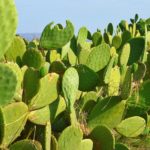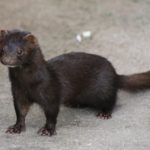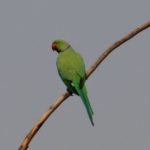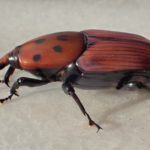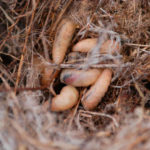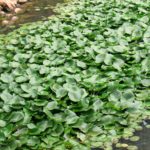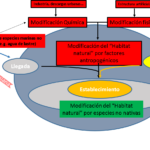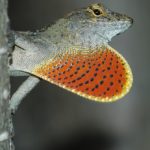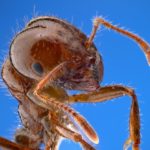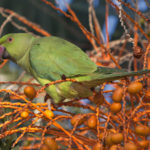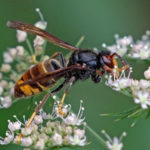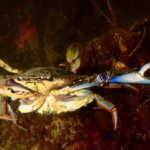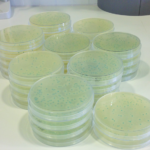Las especies invasoras: un problema ambiental de origen humano
- FAGUNDEZ, J.; BARRADA, M. (2007) Plantas invasoras de Galicia. Bioloxía, distribución e métodos de control. Consellería de Medioambiente, Xunta de Galicia.
- FAGUNDEZ, J. (2019) Plantas exóticas invasoras en Galicia. Doce años de avances en el conocimiento. Conference Paper en Especies Exóticas Invasoras: situación e propostas de mitigación. A Coruña. Monografías do Instituto de Biodiversidade Agraria e Desenvolvemento Rural, serie biodiversidade. pp: 61-66
- PRINGLE, R.M. (2005) The origins of the Nile Perch in Lake Victoria. BioScience, 55. pp: 780-787 | DOI: 10.1641/0006-3568(2005)055[0780:TOOTNP]2.0.CO;2
- MONCEAU, K.; THIERY, D.; BONNARD, O. (2014) Vespa velutina: a new invasive predator of honeybess. Journal of Pest Science, 87(1). | DOI: 10.1007/s10340-013-0537-3
En los límites del término “especie invasora”: revisión histórica de la chumbera
- Barrios, C.R.P. (2004). El tabaco, una alternativa a la cochinilla en el Sur de Tenerife a finales del siglo XIX. In XV Coloquio de historia canario-americana (pp. 967-982). Cabildo de Gran Canaria.
- Capdevila-Argüelles, L., Zilletti, B., & Suárez-Álvarez, V.Á. (2013). Causas de la pérdida de biodiversidad: Especies Exóticas Invasoras. Memorias Real Sociedad Española de Historia Natural. 2a. época, 10.
- Coevoluciona (2014). La grana una plaga muy valorada antaño. https://ecolucionamalaga.com/2014/02/13/la-grana-una-plaga-muy-valorada-antano/
- De Jesús Concepción, L.S.M. (2005). Relación entre métodos de secado de cochinilla silvestre (Dactylopius sp.) y el rendimiento de ácido carmínico. Tesis. Universidad de Guadalajara. México. CICLO 2005-A, CÓDIGO 084362735.
- Elnopal. (2019) Como combatir la plaga de la cochinilla de las chumberas. https://youtu.be/XVLB2susjUU https://nopalverdura.com/eliminar_cochinilla_chumbera.html
- Halcón, R.M.Á. (2014). Las especies exóticas invasoras en la legislación española. Especies Exóticas Invasoras, 14.
- Kiesling, R. (1998). Origen, domesticación y distribución de Opuntia ficus-indica. Journal of the Professional Association for Cactus Development, 3, 50-59.
- Kiesling, R. (2013). Historia de la Opuntia ficus-indica. CACTUSNET, 13.
- Nogales, L. A. (2012). Origen de los nombres grana y cochinilla utilizados para nombrar a Dactylopius coccus Costa. Bol. Nakari, 23(2): 19-20
- Portela, R. (2017) Especies invasoras (V): La uña de gato o Carpobrotus: un problema ornamental. Cienciaybiología. https://cienciaybiologia.com/carpobrotus-edulis/
- Rodrigo, E., Catalá-Oltra, M., & Granero, M. (2010). Comparative study of the morphology and biology of Dactylopius coccus Costa y D. opuntiae (Cockerell)(Hemiptera: Dactylopiidae), two species present in the Valencian Community. Boletín de Sanidad Vegetal, Plagas, 36(1), 23-35.
- Salas Pascual, M., & Laguna Lumbreras, E. (2012). El catálogo español de especies exóticas invasoras, ¿una oportunidad perdida?. Conservación vegetal.
- Serrano-León, J.P. Imagen de Opuntia dillenii. Proyecto AlmaZen, vinculado al proyecto Flora Vascular de Bioscripts.net. https://www.floravascular.com/almazen/galeria.php?autor=jpsl
- Ulloa, F.R.V. (2015). HEMIPTERA: La grana cochinilla y los errores en la interpretación de su historia. Dugesiana, 17(1). [Todas las referencias dentro de este trabajo fueron revisadas]
- Documentación obtenida del Archivo de Indias a través de la Plataforma PARES
- 1619 – Consejo de Indias – ES.41091.AGI/23.1.606//BUENOS_AIRES,2,L.5,F.128V-129V. Archivo General de Indias.
- 1620 – Sobre la explotación de la cochinilla. Solicitud formal de Francisco de la Hoz Berrio, gobernador de Venezuela, ordenando trasplantar y cultivar el nopal y la cochinilla – ES.41091.AGI/23.14//SANTO_DOMINGO,869,L7,5.95V. Archivo General de Indias.
- 1798 – José Hipólito Bernal y Serrano sobre beneficio de la Grana – ESTADO,51,N.7. Archivo General de Indias.
- 1821 – Dibujos del insecto llamado grana o cochinilla, su cosecha y procesado en Oaxaca – ES.41091.AGI//MP-MEXICO,515. Archivo General de Indias.
1822 – Expedientes tramitados por Gobernación de Ultramar – ES.41091.AGI/36//ULTRAMAR.108. Archivo General de Indias.
Infografía: Invasión de cotorras en España
- Lucrecia Souviron-Priego, Antonio Román Muñoz, Jesús Olivero, J. Mario Vargas, John E. Fa “The Legal International Wildlife Trade Favours Invasive Species Establishment: The Monk and Ring-Necked Parakeets in Spain,” Ardeola, 65(2), 233-246, (1 July 2018)
Museo en casa: Rhynchophorus ferrugineus (Olivier, 1790) – Picudo rojo.
- Cabello, Tomas. (2012). Rhynchophorus ferrugineus: biología, dispersión y modo de acción. 10.13140/2.1.4046.9284.
- Cabello, Tomas. Population Biology and Dynamics of the Red Palm Weevil Rhynchophorus ferrugineus (Olivier, 1790) (Coleptera: Dryophthoridae) in Spain. Universidad de Almería. Escuela Superior. Dpto. Biología Aplicada.
Invasión en las islas Galápagos: el caso de Philornis downsi
- Jennifer A. H. Koop, Peter S. Kim, Sarah A. Knutie, Fred Adler y Dale H. Clayton (2016). An introduced parasitic fly may lead to local extinction of Darwin’s finch populations. Journal of Applied Ecology, 53: 511-518.
- Jody A. O’Connor, Frank J. Sulloway, Jeremy Robertson y Sonia Kleindorfer (2010). Philornis downsi parasitism is the primary cause of nestling mortality in the critically endangered Darwin’s medium tree finch (Camarhynchus pauper). Biodiversity and Conservation, 19: 853-866.
- Jody A. O’Connor, Jeremy Robertson y Sonia Kleindorfer (2014). Darwin’s finch begging intensity does not honestly signal need in parasitized nests. Ethology, 120: 228-237.
- Sabrina M. McNew y Dale H. Clayton (2018). Alien invasion: biology of Philornis flies highlighting Philornis downsi, an introduced parasite of Galápagos birds. Annual Review of Entomology, 63: 369-389.
- Sonia Kleindorfer, Georgina Custance, Katharina J. Peters y Frank J. Sulloway (2019). Introduced parasite changes host phenotype, mating signal and hybridization risk: Philornis downsi effects on Darwin’s finch song. Proceedings of the Royal Society B, 286: 20190461.
La transformación de los ecosistemas acuáticos del golfo de Cádiz y el éxito en la introducción de especies no nativas
- 1 Firth, L.B., Knights, A.M., Bridger, D., Evans, A.J., Mieszkowska, N., Moore, P.J., O’Connor, N.E., Sheehan, E.V., Thompson, R.C. & Hawkins, S.J. (2016). Ocean sprawl: challenges and opportunities for biodiversity management in a changing world. In Oceanography and marine biology (pp. 201-278). CRC Press.
- 2 Byers JE, 2002. Impact of non-indigenous species on natives enhanced by anthropogenic alteration of selection regimes. Oikos 97:449–458
- 3 Johnston EL, Marzinelli EM, Wood CA, Speranz D, Bishop JDD, 2011. Bearing the burden of boat harbours: heavy contaminant and fouling loads in a native habitat-forming alga. Marine Pollution Bulletin 62, 2137–2144.
- 4 Cuesta, J. A., L. Serrano, M. R. Bravo, and J. Toja. 1996. Four new crustaceans in the Guadalquivir river estuary (SW Spain), including an introduced species. Limnetica 12, 41–45.
- 5 González-Ortegón, E., M. E. M. Walton, B. Moghaddam, C. Vilas, A. Prieto, H. A. Kennedy, J. Pedro Cañavate, and L. Le Vay.. (2015). Flow regime in a restored wetland determines trophic links and species composition in the aquatic macroinvertebrate community. Science of the Total Environment, 503, 241-250.
- 6 Winder M, Jassby AD, Mac Nally R, 2011. Synergies between climate anomalies and hydrological modifications facilitate estuarine biotic invasions. Ecology Letters 14, 749–757.
- 7 Rius M, Potter EE, Aguirre JD, Stachowic JJ, 2014. Mechanisms of biotic resistance across complex life cycles. Journal of Animal Ecology 83, 296–305.
- 8 Hall LW, Scott MC, Killen WD, 1998. Ecological risk assessment of copper and cadmium in surface waters of Chesapeake watershed. Environmental Toxicology and Chemistry 17:1172–1189.
El anolis café: en proceso de expansión
- Gerber, G.P. y A.C. Echternach. 2000. Evidence for asymmetrical intraguild predation between native and introduced Anolis lizards. Oecologia 124:599-607.
- Gosse, P.H. (1850) Description of a new genus and six new species of saurian reptiles. Annals and Magazine of Natural History, Ser. 2(6), 344–348.
- https://commons.wikimedia.org/wiki/File:Anolis_sagrei_t%C3%AAte.JPG
- Huang, S.C., G. Norval y I.M. Tso, 2008. Predation by an exotic lizard, Anolis sagrei, alters the ant community structure in betelnut palm plantations in southern Taiwan. Ecological Entomology, 33: 569–576.
- Lee JC, Clayton D, Eisenstein S, Pérez I. 1989. The Reproductive Cycle of Anolis sagrei in Southern Florida. Copeia 1989 (4): 930–937.
- Rodríguez-Gómez, y., A. Sanz-Ochotorena, N. Almaguer Cuenca. 2006. El conteo espermático en cinco especies del género Anolis (Sauria: Polychrotidae) y su relación con la eficiencia reproductiva. Biología. 20(12): 76-79.
Un imperio de fuego: Solenopsis invicta
- Burke WA. The red imported fire ant (Solenopsis invicta). A problem in North Carolina. N C Med J. 1991;52(4):153–158.
- Allen ML, Rhoades JH, Sparks ME, Grodowitz MJ. Differential Gene Expression in Red Imported Fire Ant (Solenopsis invicta) (Hymenoptera: Formicidae) Larval and Pupal Stages. Insects. 2018;9(4):185. Published 2018 Dec 5. doi:10.3390/insects9040185
- Hölldobler B, Wilson EO. 1990. The Ants. pp. 165. Belknap Press.
Vivir lejos de casa
- Kenn Kaufman. Audubon. Recuperado de https://www.audubon.org/es/guia-de-aves/ave/cotorra-de-kramer (31 de enero de 2020)
- ,MatthysenE.,2007.Invasivering-neckedparakeetsPsittaculakrameriinBelgium: habitatselectionandimpactonnativebirds.Ecography30: 578–588. (12 de febrero de 2020)
- , MatthysenE., 2009.Experimentalevidencefornest-sitecompetitionbetween invasive ring-necked parakeets (Psittacula krameri) and native nuthatches (Sitta europaea).BiologicalConservation,142(8),1588–1594. (12 de febrero de 2020)
- AncillottoL, TomassiniA, RussoD. 2015 Thefancy citylife: Kuhl’spipistrelle, Pipistrelluskuhlii, benefits fromurbanization. Res.42,598–606. (doi:10.1071/WR15003) (13 de febrero de 2015)
- BlackburnTM,LockwoodJL,Cassey,P.2009Avian invasions:the ecology and evolution of exotic birds. Oxford,UK:OxfordUniversityPress.(13 de febrero de 2020)
- Clergeau P, Vergnes A. Bird feeders may sustain feral Rose-ringed parakeets Psittacula krameri in temperate Europe. Wildl Biol 2011; 17: 248-52. (13 de febrero de 2020)
El caso de la avispa asiática: como una maceta condenó un continente:
- Villemant, C., Haxaire, J. and Streito, J. C. (2006). Premier bilan de l’invasion de Vespa velutina Lepeletier en France (Hymenoptera, Vespidae). Bulletin de la Société entomologique de France 111(4) : 535-538
- Gévar, J., Bagnères, A. G., Christidès, J. P. and Darrouzet, E. (2017). Chemical Heterogeneity in Inbred European Population of the Invasive Hornet Vespa velutina nigritorax. Chem Ecol 43: 763-777
- Haro, L., Labadie, M., Chanseau, P., Cabot, C., Blanc-Brisset, I. and Penouil, F. (2010). Medical consequences of the Asian black hornet (Vespa velutina) invasion in Southwestern France. Toxicon 55 (2): 650-652
- Gallai, N., Salles, J. M., Settele, J. and Vaissière, B. E. (2008). Economic valuation of the vulnerability of world agriculture confronted with pollinator decline. Ecological Economics 68: 810-821
Una introducción acuática que está dejando huella en la Península Ibérica: el cangrejo azul americano Callinectes sapidus Rathbun, 1896 en el Mar Menor y el Golfo de Cádiz
- Drake JM, Lodge DM, 2006. Allee Effects, Propagule Pressure and the Probability of Establishment: Risk Analysis for Biological Invasions. Biological Invasions, 8: 365–375.
- Por FD, 2012. Lessepsian migration: the influx of Red Sea biota into the Mediterranean by way of the Suez Canal (Vol. 23). Springer Science & Business Media
- 2005. Vector pathways and the spread of exotic species in the sea. ICES Cooperative Research Report, No. 271, 25 pp
- Calado R, Chapman CM (2006) Aquarium species: deadly invaders. Mar Pollut Bull 52:599–601
- Perez-Miguel M, Drake P, García Raso, JE, Mamán Menéndez L, Navas JI, Cuesta JA (2019) European Pinnotheridae (Crustacea, Decapoda, Brachyura): species, distribution, host use and DNA barcodes. Mar Biodivers 49 Doi:10.1007/s12526-017-0754-8
- Dawson W, Moser D, van Kleunen M, Kreft H, Pergl J, Pyšek P, Weigelt P, Winter M, Lenzner B, Blackburn TM, Dyer EE (2017) Global hotspots and correlates of alien species richness across taxonomic groups. Nat Ecol Evol 1: 0186.
- Bonanno G, Orlando-Bonaca M (2019) Non-indigenous marine species in the Mediterranean Sea—Myth and reality. Environ Sci Technol 96:123-31.
- Acosta, M., Coronado, D., & Mar Cerban, M. (2007). Port competitiveness in container traffic from an internal point of view: the experience of the Port of Algeciras Bay. Maritime Policy & management, 34(5), 501-520.
- Cuesta JA, Almón B, Pérez-Dieste J, Trigo JE, Bañon R, 2016. Role of Ships´ hull fouling and tropicalization process on European carcinofauna: new records in Galician waters (NW Spain). Biological Invasions, 18(3): 619-630.
- Streftaris N, Zenetos A, 2006. Alien marine species in the Mediterranean-the 100 ‘Worst Invasives’ and their impact. Mediterranean Marine Science, 7(1), 87-118.
- Enzenroß R, Enzenroß L, Bingel F, 1997. Occurrence of blue crab, Callinectes sapidus (Rathbun, 1896) (Crustacea, Brachyura) on the Turkish Mediterranean and the adjacent Aegean coast and its size distribution in the bay of Iskenderun. J. Zool. 21, 113–122.
- Morais P, Gaspar M, Garel E, Baptista V, Cruz J, Cerveira I, Leitao F, Teodosio M, 2019. The Atlantic blue crab Callinectes sapidus expands its non-native distribution into the Ria Formosa lagoon and the Guadiana estuary (SW-Iberian Peninsula). BioInvasions Records, 8: 123-133.
- Castejón D, Guerao G, 2013. A new record of the American blue crab, Callinectes sapidus Rathbun, 1896 (Decapoda: Brachyura: Portunidae), from the Mediterranean coast of the Iberian Peninsula. Bioinvasions Rec. 2, 141–143.
- Preston DL, Henderson JS, Johnson PTJ, 2012. Community ecology of invasions: direct and indirect effects of multiple invasive species on aquatic communities.Ecology,93:1254–1261
- Geiger W, Alcorlo P, Baltanas A, Montes C, 2005. Impact of an introduced Crustacean on the trophic webs of Mediterranean wetlands. Biological Invasions, 7:49-73.
- Whitney KD, Gabler CA, 2008. Rapid evolution in introduced species,‘invasive traits’ and recipient communities: challenges for predicting invasive potential. Diversity and Distributions, 14: 569-580.
- González-Ortegón E, Walton MEM, Moghaddam B, Vilas C, Prieto A, Kennedy H, Le Vay L, 2015. Flow regime in a restored wetland determines trophic links and species composition in the aquatic macroinvertebrate community. Science of the Total Environment, 503, 241-250.
- Wallentinus I, Nyberg CD, 2007. Introduced marine organisms as habitat modifiers. Marine pollution bulletin, 55(7-9), 323-332.
Listeria monocytogenes: un invasor humano microscópico escondido en alimentos
- Alía A., Andrade M.J., Córdoba J.J., Martín I., Rodríguez A. (2020). Development of a multiplex real-time PCR to differentiate the four major Listeria Monocytogenes serotypes in isolates from meat processing plants. Food Microbiol. 87: Article number 103367.
- Arias-Rios, E.V., Cabrera-Diaz, E., Marquez-Gonzalez, M., Castillo, A. (2017).Natural Food Antimicrobials of Animal Origin. En Microbial control and food preservation: theory and practice. Edited by:Juneja, VK; Dwivedi, HP; Sofos, JN, Book Series: Food Microbiology and Food Safety Pages: 55-83. DOI: 10.1007/978-1-4939-7556-3_4.
- Arqués, J.L. Tratamientos combinados de bacteriocinas y otros sistemas inhibitorios para la mejora de la seguridad de los productos lácteos. (2003). Tesis doctoral. Directores de la Tesis: Margarita Medina Fernández-Regatillo y Eva Rodríguez Mínguez. en acceso abierto en: E-Prints Complutense.
- Arques, J.L.; Rodriguez, E.; Langa, S., Landete, J.M., Medina M. (2015). Antimicrobial Activity of Lactic Acid Bacteria in Dairy Products and Gut: Effect on Pathogens. Biomed Research International. Article Number:584183
- Arslan S., Özdemir F. (2020). Prevalence and antimicrobial resistance of Listeria species, and virulence genes, serotyping, PCR-RFLP and PFGE typing of Listeria monocytogenes isolated from retail ready-to-eat foods. FEMS Microbiol Lett. 11. pii: fnaa006. doi: 10.1093/femsle/fnaa006.
- Birmpa A., Sfika V., Vantarakis A. (2013). Ultraviolet light and ultrasound as non-thermal treatments for the inactivation of microorganisms in fresh ready-to-eat foods. Int. J. Food Microbiol., 167:96-102.
- Buchanan R.L., Gorris L.G.M, Hayman M.M., Jackson T.C., Whiting, R.C. (2017). A review of L. monocytogenes: An update on outbreaks, virulence, dese-response, ecology, and risk assessments. Food Control 75: 1-13.
- Can F.O., Demirci A., Puri V.M., Gourama H. (2014). Decontamination of hard cheeses by pulsed UV light. J. .Food Protect. 77: 1723-1731.
- CCFRA 2006. Pasteurization: a food industry practical guide (second edition). Guideline 51. Campden and Chorlewwod Food Research Association.
- de Alba, M. Bravo, D.; Medina, M. (2015) Inactivation of Listeria monocytogenes and Salmonella Enteritidis in dry-cured ham by combined treatments of high pressure and the lactoperoxidase system or lactoferrin. Innovative Food Science & Emerging Technologies 31: 54-59.
- de Noordhout C.M., Angulo F.J., Verbeke G., Haagsma J., Kirk M., Havelaar A., Speybroeck N. (2014). The global burden of listeriosis: a systematic review and meta- analysis. Lancet Infect. Dis. 14:1073-1082.
- Doumit, M., Buchrieser C., Glaser P., Jacqet C., Martin P. (2004). Differentiation of the major Listeria monocytogenes serovars by multiplex PCR. J. Clin. Microbiol., 42 (2004), pp. 3819-3822
- Ferreira V., Wiedmann M., Teixeir, P., Stasiewiccz (2014). Listeria monocytogenes persistence in food-associated environments: epidemiology, strain characteristics, and implications for public health. J. food protect. 77: 150-170.
- Gianfranceschi M.V., D ́Ottavio M.C., Gattuso A., Bella A., Aureli P. (2009).Distribution of serotypes and pulsotypes of Listeria monocytogenes from human, food and environmental isolates (Italy 2002–2005).Food Microbiol., 26: 520-526.
- Gurtler, J.B. , Fan, X.T. , Jin, T., Niemira, B.A. (2019). Influence of Antimicrobial Agents on the Thermal Sensitivity of Foodborne Pathogens: A Review. J. Food Protect. 82:628- 644.
- Herrador, Z., Gherasim, A., López-Vélez, R., Benito, A. (2019). Listeriosis in Spain based on hospitalization records, 1997 to 2015: need for greater awareness. Euro Surveill. 2019 May:24(21): doi.org/10.2807/1560-7917.ES.2019.24.21.1800271.
- Ju J., Xie, Y.F., Guo, Y.H., Cheng, Y.L., Qian, H., Yao, W.R.(2019). The inhibitory effect of plant essential oils on foodborne pathogenic bacteria in food. Critical reviews in food science and nutrition 59: 3281-3292.
- Kljujev I., Raicevic V., Jovicic-Petrovic J., Vujovic B., Mirkovic M., Rothballer M. (2018). Listeria monocytogenes – Danger for health safety vegetable production. Microb Pathog. 120:23-31
- Komora N., Maciel C., Pinto C.A., Ferreira V., Brandao S.M. Texeira P. (2020). Non- thermal approach to Listeria monocytogenes inactivation in milk: The combined effect of high pressure, pediocin PA-1 and bacteriophage P100. Food Microbiol. 86: Article Number: 103315
- Leclercq A., Charlier C., Lecuit M. Global burden of listeriosis: the tip of the iceberg. Lancet Infect Dis 2014;14:1027-1028.
- Lucas-López J.R., Selgas-Cortecero M.D., García Sanz M.L. (2020). Control of Listeria monocytogenes in boned dry-cured ham by E-beam treatment. J. .Food Safety: e12757.
- McLauchlin J., Mitchell R.T., Smerdon W.J. Jewell, K. (2004). Listeria monocytogenes and listeriosis: a review of hazard characterization for use in microbiological risk assessments of foods. Int. J. Food Microbiol. 92: 15-35.
- Pao S., Ettinger M.R. (2019). Comparison of the microbial quality of ground beef and ground beef patties from Internet and local retail markets. J Food Prot. 72:1722-1726.
- Pérez-Baltar A., Serrano A., Montiel R. and Medina M. (2020). Listeria monocytogenes inactivation in deboned dry-cured hams by high pressure processing. Meat Sci. 160:107960.
- Pyatkovskyy I.T., Shynkaryk M.V., Mohamed H.M., Yousef A.E., Sastry S.K. (2018). Effects of combined high pressure (HPP), pulsed electric field (PEF) and sonication treatments on inactivation of Listeria innocua. J. Food Eng. 233: 49-56.
- Radoshevich L y Cossart P. (2018). Listeria monocytogenes towards a complete picture of its physiology and pathogenesis. Nature Reviews Microbiology, 1:32-46.
- Sheng J., Tao T., Zhu X., Bie X., Lv F., Zhao H., Lu Z.. (2018). A multiplex PCR detection method for milk based on novel primers specific for Listeria monocytogenes 1/2a serotype. Food Control, 86: 183-190.
- Suárez M., Pérez M., González S., Rodríguez D., Domínguez L. (2019). Listeria: historia de la Histeria. Veterinaria año 23, no 93. (Diciembre 2019-marzo 2020).
- Swaminathan B, Gerner-Smidt P. The epidemiology of human listeriosis. Microbes Infect 2007;9:1236-1243.
- Valero A., García –Gimeno R.M., Carrasco E., Pérez-Rodríguez F., Posada-Izquierdo, G.D., Zurera, G. (2019).Alerta sanitaria por listeriosis en España. Enfoques preventivos basados en un esquema de evaluación de riesgos. Revista SEM@FORO, diciembre 2019. 68:8-10.
- Zhang Z-H, Wang L-H., Zeng X-A, Han Z., Brennan C.S. (2019). Non-thermal technologies and its current and future application in the food industry. Int. J of Food Sci. Tech 54: 1- 13.
- Zhang, E. Yeh, G. Hall, J. Cripe, Bhagwat A.A., Meng J. (2007). Characterization of Listeria monocytogenes isolated from retail foods. Int. J. Food Microbiol. 113: 47-53.
33. Zhenhong G., Daliri, E.B.M., Banan-Mwine; Wang, J., Liu D.H., Chen S.G., Ye X.Q., Ding T. (2019). Inhibitory Effect of Lactic Acid Bacteria on Foodborne Pathogens: A Review. Journal of Food Protection 82: 441-453.
